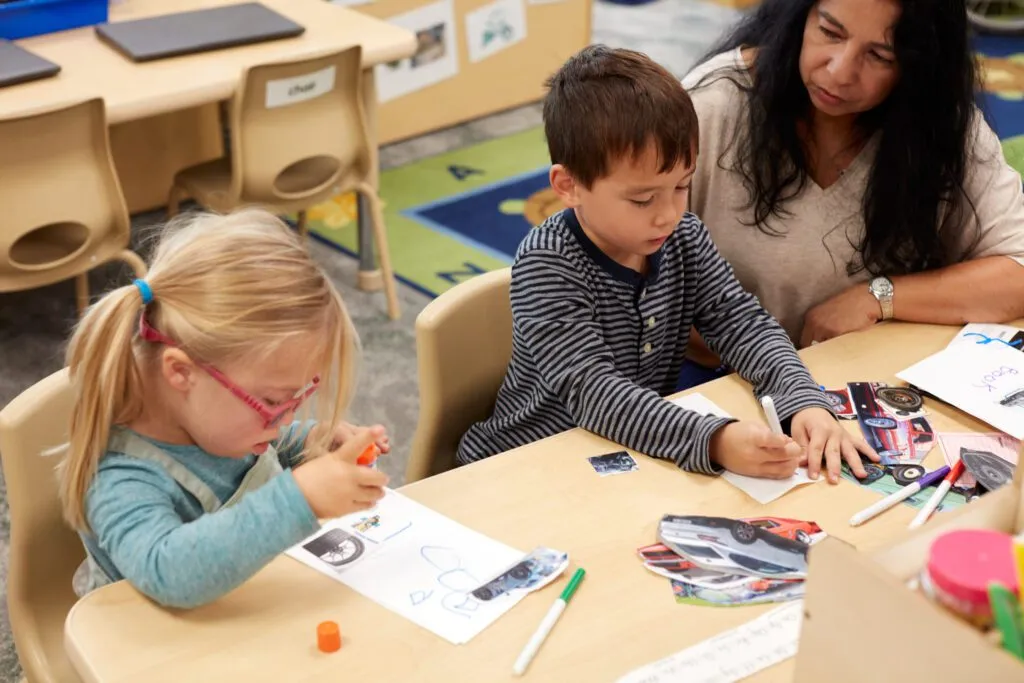Implementing the Science of Reading in Pre-K: A Guide for School Administrators


School administrators have a crucial role in shaping early literacy learning, and right now many administrators are considering how they can incorporate the science of reading into their programs. The science of reading informs evidence-based practices that enhance reading proficiency for children from a young age. However, executing these strategies in developmentally appropriate ways for pre-K requires thoughtful planning and resource allocation.
1. Understanding the Science of Reading
Before diving into program execution, administrators need to grasp the foundational principles of the science of reading. The science of reading has organized the fundamentals of literacy learning into five categories, often referred to as the “five pillars of literacy”: phonemic awareness, phonics, vocabulary development, fluency, and comprehension. Administrators must be knowledgeable about these concepts in order to ensure that their programs’ practices are being effectively implemented and in line with the science of reading.
Teaching Strategies Tip: Our recent e-book, “Five Everyday Practices to Promote Essential Skills in Language and Literacy,” shares developmentally appropriate ways to incorporate science of reading research into programs. It also includes special guidance for leaders and administrators who may want to use this e-book as a basis for professional development plans.
2. Professional Development for Educators
Professional development is essential for early childhood educators, as it enhances their teaching practices, supports child-centered learning, and improves classroom management. It helps educators stay updated on the latest research, foster cultural competence, and strengthen relationships with families. Administrators can support teachers’ success and children’s learning by providing ongoing professional development that focuses on the science of reading.
-
- Workshops and Training: Provide opportunities for educators to learn about evidence-based literacy instruction strategies.
- Coaching and Mentoring: Pair experienced teachers with those who are newer to these methodologies to foster a collaborative learning environment.
- Resources: Supply access to research articles, books, and online courses that delve deeper into the science of reading.
Teaching Strategies Tip: The Teaching Strategies Professional Development Teacher Membership provides access to over 400 hours of content, unlimited CEU-bearing classes and courses, and a community of 100K educators and experts. For those interested in even more professional development related to the science of reading, our Professional Development Teacher Membership Plus includes our Early Literacy Certification, our comprehensive certification designed to improve teachers’ ability to deliver high-quality language and literacy instruction.
3. Curriculum Selection and Alignment
Choose a high-quality curriculum that is aligned with principles based in the science of reading. Ensure that daily practices provide a scientific approach to reading instruction that is also developmentally appropriate for young children.
-
- Functional Literacy: Immerses children in literacy and shows them the importance of literacy in all areas of their play
- Pre-Reading Skills: Integrates phonological and phonemic awareness by encouraging sound play, blending, segmenting, and manipulating sounds
- Play-Based Learning: Embeds literacy skills in hands-on, play-based activities that align with how young children learn best
- Intentional/Explicit Teaching: Guides intentional, explicit teaching of language/literacy skills, including phonics, vocabulary, and comprehension for small groups and the individual child
- Meaningful Book Discussions: Includes rich, diverse texts and discussions that expand children’s vocabulary and comprehension skills
- Family Resources: Provides families with fun, developmentally appropriate activities that promote early literacy and connect to classroom instruction
Teaching Strategies Tip: The Creative Curriculum for Pre-K is aligned to early learning guidelines in each state; includes daily experiences for learning language, literacy, and math; and employs a culturally and linguistically responsive approach that is whole child- and play-based.
4. Creating a Print-Rich Environment
A print-rich environment is essential in early childhood classrooms for supporting language development, early literacy skills, and cognitive growth. It helps children connect spoken and written language, encourages independent learning, and fosters a love of reading and writing. Providing access to various printed materials, such as books, labels, and posters, encourages children to engage with literacy in meaningful ways and strengthens their pre-writing skills. This environment ultimately enhances their overall learning experience.
-
- Provide Rich, Diverse Reading Materials: Ensure classrooms are stocked with a variety of books from a variety of genres, including fiction, nonfiction, and culturally relevant texts. Ensure that these include complex stories with characters who must find solutions for their problems.
- Incorporate Technology Wisely: Select age-appropriate educational apps and tools that reinforce literacy skills without overshadowing hands-on experiences.
Teaching Strategies Tip: The Creative Curriculum for Pre-K includes foundation volumes featuring a wealth of research and information on developing print-rich classrooms, including such how to set up learning areas to encourage pre-reading and pre-writing practice and make environmental print meaningful to children.
5. Family Engagement
Involving families as partners in literacy reinforces learning at home and school, supports language and vocabulary growth, and fosters positive attitudes toward reading. For multilingual learners, family involvement is especially important, as it helps bridge the gap between languages and cultures, providing additional support for language development in both the first language and English. It strengthens communication between families and teachers, encourages literacy-rich activities at home, and boosts children’s confidence and motivation. This collaboration ensures a strong foundation for early literacy development and overall academic success.
-
- Workshops for Parents: Host sessions that educate parents on the science of reading and how they can support literacy development at home.
- Take-Home Resources: Provide families with materials, such as book lists and literacy activities, that they can use to encourage reading outside of school.
- Communication: Regularly share updates on children’s progress and literacy strategies through newsletters, meetings, or digital platforms.
Teaching Strategies Tip: ReadyRosie provides researched based, evidence-informed family engagement directly tied to classroom instruction. Mobile-friendly Modeled Moments videos, which are filmed in English and Spanish, show real families modeling fun activities that support early literacy and classroom learning in authentic ways.
6. Creating a Supportive Culture
Fostering a school culture that supports literacy in early childhood is essential to building a strong foundation for academic success. Administrators have a leading role in creating an environment where literacy is prioritized, which helps children develop essential reading, writing, and communication skills. This culture promotes a love of learning and encourages collaboration with families to reinforce literacy development at home. By fostering an engaging and inclusive atmosphere, administrators can ensure that all children, regardless of their background, feel supported and motivated to succeed in literacy, setting them up for lifelong success.
-
- Celebrating Reading: Highlight the importance of reading.
- Encouraging Collaboration: Create opportunities for teachers to share successful strategies and learn from one another.
- Valuing Diverse Perspectives: Recognize how families teach and share literacy experiences with their children at home, including by celebrating cultural songs and stories.
Teaching Strategies Tip: Our “six positive messages” e-book is a guide to cultivating a positive school culture by communicating six uplifting and empowering messages through the classroom communities that teachers and children build together.
By providing the necessary resources, training, and support, school administrators can create an environment where the science of reading is effectively integrated into pre-K programs. Investing in early literacy is investing in the future success of children, teaching not only a crucial skill but nurturing a love of reading that will last a lifetime.

The Creative Curriculum
for Pre-K
Prepare children for reading proficiency in third grade beginning in pre-K using our five easy-to-implement practices based on the science of reading’s five pillars.



